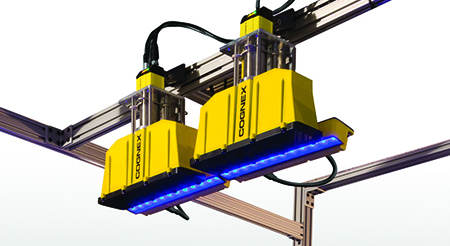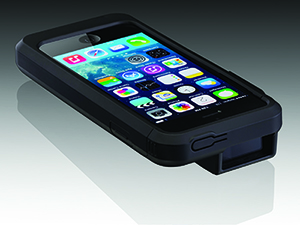Warehouse/DC Operations: Data capture is ready for its close-up
Camera-based bar code scanners are a must for 2D codes, but today’s payoff mainly ties to improving 1D code processes, ergonomics, and read rates. Here’s a look at how this versatile tool is helping to transform fulfillment accuracy in dynamic distribution environments.
Latest Material Handling News
Interest in scanning technology for two-dimensional (2D) bar codes is on the rise. But oddly enough, the business driver in many cases isn’t the need to read 2D codes, but rather to improve on processes related to one-dimensional (1D) codes. The enabler for why things are playing out this way is the camera-based technology used in these scanners.
These camera-based scan engines can read both 2D and 1D codes, and by capturing an image, you have a digital picture that can be analyzed and used in different ways.
To read a 2D code, traditional laser based scanners won’t do the trick—camera-based scan engines are needed. These camera-based scanners hold multiple benefits, from the way they can make handheld scans less fatiguing, to fixed-position scanners with image-capture capabilities that can get at the root cause for read failures.
Richa Gupta, a senior analyst for automatic identification (auto ID) technology at VDC Research, says fixed-position camera-based scanners are being used for “quality assurance” processes around bad reads and problems with labels, mainly for 1D codes.
“With laser-based systems, you couldn’t really go back and analyze what went wrong, but with these camera-based systems, because you have a visual of what is moving on a belt, it makes the process easier in terms of correcting and eliminating errors that might be there,” Gupta says.
The result is that operators now have a new tool for quality assurance on labeling and data capture, which should eventually help with fulfillment accuracy. “The technology can help ensure that data is being captured and that products are headed in the right direction,” says Gupta.
Fixed-position, camera-based scanners generate a digital “close-up” of labels and goods as they pass through points in the fulfillment chain. This close-up can be stored, analyzed, and used to correct problems.
Meanwhile, with handheld scanners and mobile devices, similar camera-based scanning also carry benefits in the form of better ergonomics, flexibility to capture 2D or 1D codes, and scan engines that perform well at short or long distances.

Fixed-position solutions
The market sector that has really driven the development of 2D and camera-based scanning is the express parcel market, says Mark Kremer, director of retail distribution for SICK, Inc., a provider of auto ID solutions.
In this segment, 2D codes, because of their ability to hold more data, are used for shipping labels. But in the broader warehousing and logistics market where 1D codes for product labels still dominate, camera-based fixed position scanners are being used for quality control purposes—or what Kremer calls “point of inspection” applications.
“An image can tell you some very specific things about the condition of a label or a product,” says Kremer. “An image, in effect, can talk.”
Images can reveal issues with label quality such as poor contrast or a damaged label, says Kremer, and some camera-based solutions can also examine the package itself, spotting package damage, improper spacing or gap between packages, or the wrong package dimensions.
“You can go beyond the label,” Kremer says. “You can determine if this product is positioned properly on the conveyor, is it undersized or oversized, or is it damaged?”
However, to make the images useful, says Kremer, they need to be easily storable and searchable. Kremer says SICK has devised compression technology to reduce image size while maintaining image quality, and has also developed a software system for analyzing problems.
This type of camera-enabled point of inspection solution is especially useful at critical inbound and outbound points in a warehouse, says Kremer. On the inbound side, a camera-based inspection point is a way to validate label and packaging compliance for goods coming into the warehouse.
“We need to understand what our vendors are delivering and whether it meets our specifications,” says Kremer. “We need to start analyzing compliance on the front end, prior to putting products into sortation.”
Similarly, on the outbound side, camera-based scan points verify and record factors like package condition and proper labels. “Before it’s shipped, you can have a searchable record of what the product looked like when it went out the door,” says Kremer.
For the midpoints in an operation, says Kremer, it’s possible that laser-based scanning is more than adequate. It should be a price/performance issue at the midpoints, adds Kremer.
According to Matt Engle, manager of product marketing for logistics at Cognex Corp., a provider of auto ID solutions, camera-based scanners have been around for many years, but they have been “line-based” scanners that function on a principle similar to a copier.
Engle says that the newer trend is an “area-based” camera that functions on a principle similar to the camera in a smart phone—and typically found at a lower price point than line-based units. The area-based cameras, says Engle, are also “point and read” in that they don’t require a focusing set up. “So the technology is getting easier to use and it’s lower cost,” says Engle.
Camera-based scanning also tends to bring better read rate performance than laser scanning because it captures multiple images—essentially sampling more data—as the item passes the scanner, which boosts performance, says Engle. “Even a read rate improvement of a percentage point or two can add up to considerable savings in a high volume setting,” he adds.
Engle agrees that quality assurance is a key driver for camera-based scanning. “Now we can have an image of the package that didn’t read and analyze it further to understand why the bad read happened,” says Engle.
Today, 2D codes are being used beyond the realm of express delivery and shipping codes. Direct parts marking in which parts are etched with a 2D code is a proven use, notes Engle, and there is growing use of 2D codes on labels and on packaging because of the ability of 2D codes to hold more data for track and trace applications or food safety.
For example, says Engle, 2D codes are being used by ice cream manufacturers as an allergen safeguard in filling and packaging. A camera-based scanner near the filling line can be used to scan a 2D code on the ice cream container to ensure that a product that contains peanuts isn’t dispensed into a container that has a code for a nut-free product.
2D capable handhelds
Camera-based scan engines also are used in hand-held scanners, according to Mike Maris, global lead for transportation, logistics, and warehousing with Motorola, which offers auto ID solutions. Improvements in the scan engines have done away with some of the drawbacks of earlier generation camera-based scanners, says Maris, which were relatively slow in capturing data and could only scan labels at short distances.
Today’s camera-based scan engines for handhelds, says Maris, are not only fast, but some have features that allow a scanner to read a bar code from a few feet away or 30 feet away. This is a plus in a distribution center setting where a worker may need to scan a label up high on a rack.
Laser-based scanners are also fast and have become capable of reading codes at longer distances, but one factor they can’t match camera-based units is on ease of the scan motion, says Maris.
Conventional laser scanners need to be swiped across the bar code in one direction, whereas camera-based units are omni-directional because they focus in on the target in a free-form motion. “Omni-directional is important, because it does away with the highly repetitive motion you need with a lot of scanning,” says Maris. “With a camera-based scanner, you no longer have to twist and turn a certain way to get a good read.”
Maris notes established use of 2D codes in various markets. For example, direct parts marking in the automotive sector. In the electronics industry, small paper-based 2D bar codes are placed on components to identify exactly which parts went into a product.
Pharmaceutical packaging is another application for 2D codes, says Maris. With the growth of retail super stores that sell a mix of groceries, pharmaceuticals, and items like apparel, the retail industry now has a bigger need for multifunction scanners capable of reading 2D codes, says Maris.
Because of the inherent ability of 2D codes to hold more data than 1D codes, the potential use cases are many, especially for track-and-trace related functions, agrees Bruce Stubbs, director of industry marketing at Intermec by Honeywell, a provider of auto ID equipment.
“It’s practically limitless what you can convey with a 2D code” says Stubbs. “Also, because you are generating an image, you can tell the condition of things—is the box damaged, and is it packaged in the right way?”
One niche where handhelds with camera-based scanning are starting to see use, says Stubbs, is by orchards and farms for “point of harvest” traceability. When combined with portable printer units, camera-based handhelds allow workers in these settings to generate labels and begin tracking the product’s history.
“All of that information the grower wrote to the 2D code then follows the goods and makes them traceable at a very detailed level,” says Stubbs.
Ruggedized smart phones
Outside the Intermec brand, Honeywell also offers ruggedized smart phones with camera-based imagers, as well as “sleds” for smart phones. A sled is a hardware sleeve that can give a phone scanning or credit card processing capability.
According to Stubbs, rugged mobile devices are suited to uses such as field service where the occasional scan is needed, and the worker needs access to multiple enterprise applications and a larger screen.

Andrew Graham, president of Infinite Peripherals, a provider of sleds for iPhones and iPods, says his company is preparing to target the warehousing, logistics, and transportation markets with a more rugged sled with longer battery life. Graham says that while the retail sector has been his company’s primary market, sleds could prove a good complement to more traditional scanners and highly ruggedized devices in the logistics market.
With sleds, says Graham, a company can take advantage of the easiest to use, most innovative mobile devices, which today, are consumer devices. “Ten years ago, it used to be the enterprises that had the most cutting edge hardware, but now that’s been reversed, and consumers are walking around with the cutting edge mobile devices,” he says. “We’re basically enabling consumer devices to function as enterprise devices with the addition of our sleds.”
However, the scan gun form factor isn’t about the go away, says Stubbs. Today’s camera-based handhelds are rugged, can read at long or short distances, and have the 1D and 2D capability needed to support everything from 1D scans for picking or receiving, to 2D code capture for applications such as traceability and food safety.
“Industries are really opening some doors to creative thinking on how to take advantage of this technology,” says Stubbs.

Article Topics
Magazine Archive News & Resources
Latest in Materials Handling
NetLogistik partners with Vuzix subsidiary Moviynt to offer mobility solutions for warehouses Materials Handling Robotics: The new world of heterogeneous robotic integration Lucas Watson appointed CSO for Körber’s Parcel Logistics business in North America Hyster recognizes Dealers of Distinction for 2023 Carolina Handling names Joe Perkins as COO C-suite Interview with Keith Moore, CEO, AutoScheduler.AI: MODEX was a meeting place for innovation Walmart deploying autonomous lift trucks at four of its high-tech DCs More Materials HandlingSubscribe to Materials Handling Magazine

Find out what the world's most innovative companies are doing to improve productivity in their plants and distribution centers.
Start your FREE subscription today.
April 2024 Modern Materials Handling

Latest Resources










